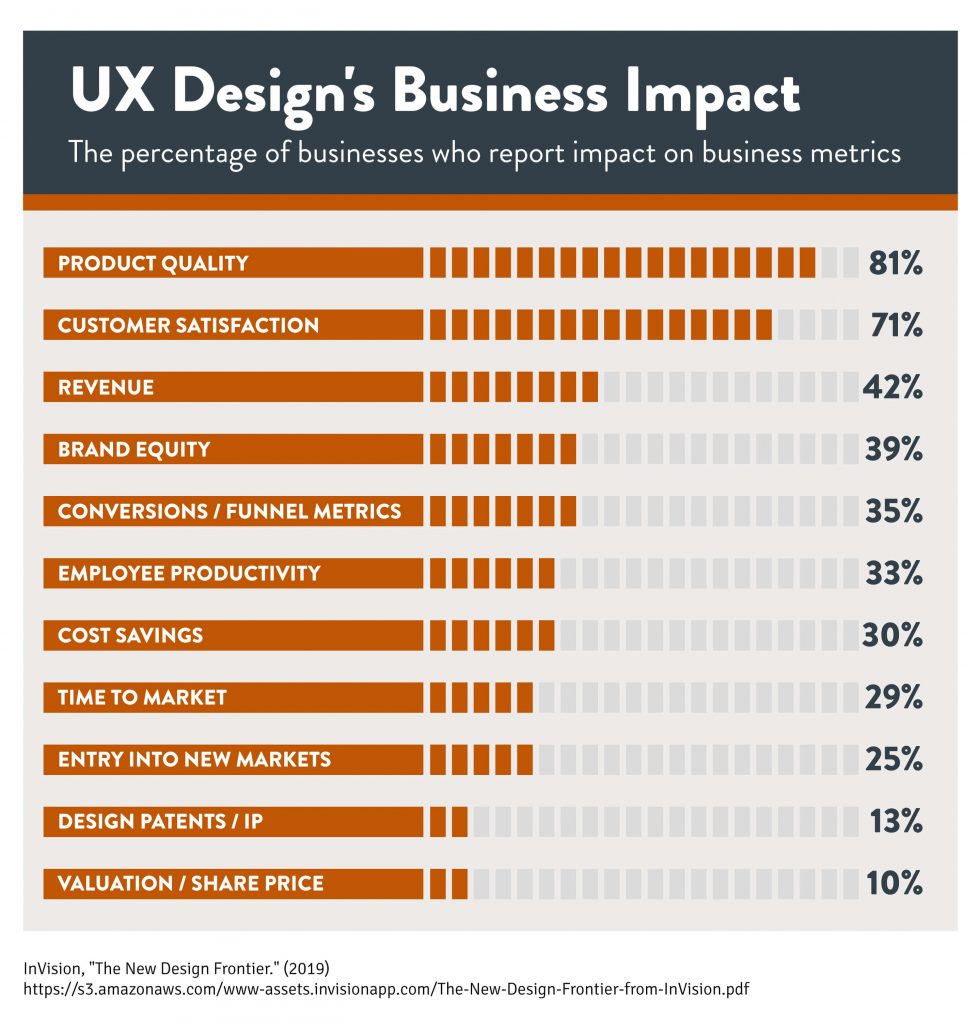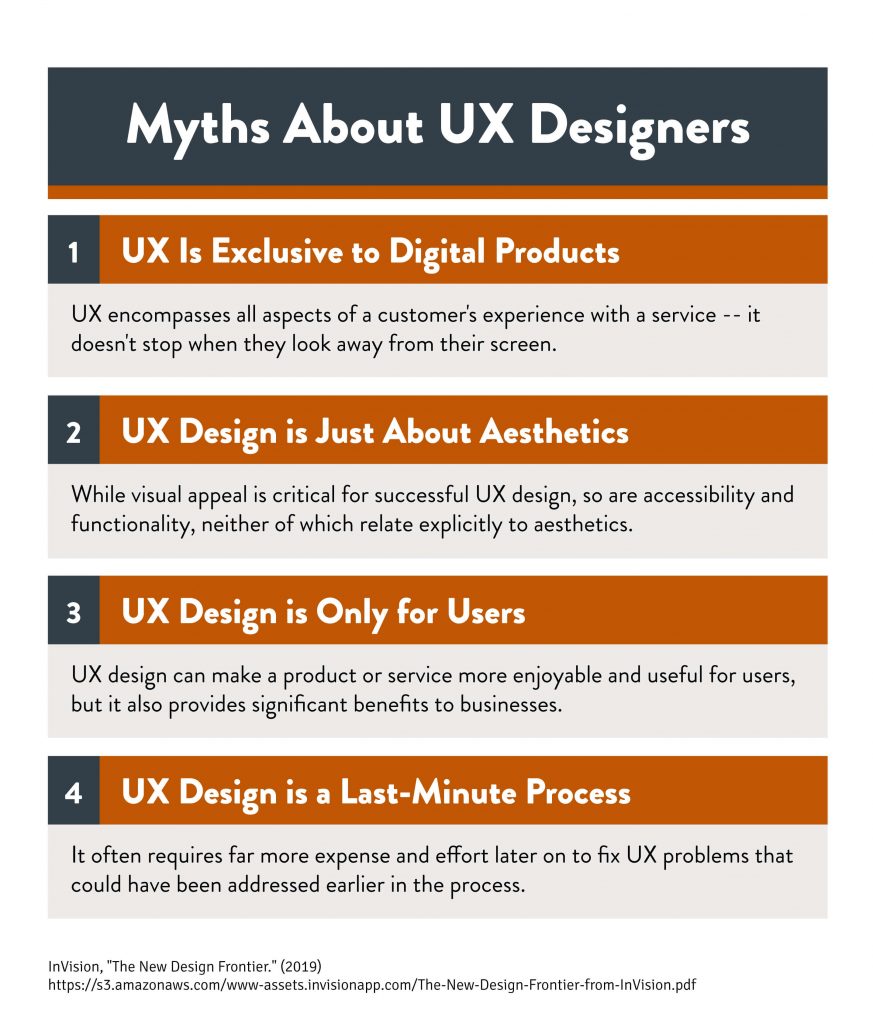How to Become a UX Designer in 5 Steps — With No Experience

Have you ever wondered how to become a UX designer? If you have an eye for design and a passion for improving clunky products, you might be the perfect fit for a career in the field.
UX design is simply a shorthand term for user experience design. It encompasses the many ways that people interact with a product or system.
Needless to say, the quality of design can dramatically change a consumer’s impression of a product. As a UX designer, you have the opportunity to shape a user’s experience for the better — and have a potentially enormous impact on the success of the product.
Interested?
Broadly speaking, to become a UX designer you need to:
- Understand What a UX Designer Does and Why It Matters
- Look for Overlapping and Existing Creative Skills, Experience, or Interests
- Choose Your Educational Path and Start Learning
- Build Up Your Portfolio
- Begin Your Job Search
In this article, we’ll explore what a UX professional is and what they actually do on a day-to-day basis, as well as lay to rest some common myths. We’ll also explain how to become a UX designer even if you don’t have any knowledge of the industry (yet).
Let’s dive in!
1. Understand What a UX Designer Does and Why It Matters
To put it bluntly, good UX design is critical in modern business.
According to InVision’s 2019 report on The New Design Frontier, 81 percent of surveyed business respondents said that their design team had a proven positive impact on product usability, while 71 percent claimed that good design boosted customer satisfaction. Another 42 percent said that it improved revenue, and 30 percent said it led to cost savings.

As researchers for the report wrote, “Companies in our study reported that when design takes center stage, it can have a direct impact on tangible business results, like revenue, valuation, and time to market.”
These results echo a 2018 McKinsey study on the Business Case for Design, in which researchers found a strong correlation between high scores for design and top-of-the-line business performance across various sectors and industries.
McKinsey also noted that companies with top-tier design scores tended to increase their revenues and total returns to shareholders (TRS) significantly faster than their more average peers. These high-performing businesses reported 32 percentage points higher revenue growth, and 56 percentage points higher TRS growth over the five-year study period.
The benefits of investing in quality design are worthwhile — and as a result, companies have a strong desire to invest in UX. In 2019, Onward Search noted in its survey of in-demand digital talent that UX designers were the second-most in-demand group of professionals of the year, while UI designers took the third spot.
The job market is only growing; analysts for DICE Insights project that the market will rise 14.9 percent in the coming decade as more companies seek to improve and expand their design portfolios.
With these promising job prospects and compelling value to businesses, you’re probably wondering what UX designers actually do all day.
That’s a great question. If you want to learn how to become a UX designer, you must first understand what the role entails. Let’s dive into the day-to-day responsibilities and dispel a few myths about this career choice.
UX Design On the Job
UX designers work within teams to create meaningful experiences for the users of a product or service. The job typically encompasses a range of initiatives related to design, including branding, functionality, usability, and the aesthetic look and feel of the product.
The daily tasks of UX designers vary depending on where they work and which projects they are involved with. However, their general job duties may include:
- Engaging in product research by conducting surveys, personal interviews, and user polls
- Analyzing collected data to assess what works and is important to users
- Developing “personas,” or target profiles, that reflect user interests and characteristics
- Creating the wireframes, models, and product prototypes that allow the development team to evolve the product or service through continued user testing
You might notice that there are few design-specific responsibilities listed. This is for a reason — contrary to what the name might seem to suggest, UX designers aren’t only concerned with how products look.
Let’s correct a few of the misconceptions and myths that you may have encountered when you first started looking into UX design.

Myth 1: UX Is Exclusive to Digital Products
Many people think that UX design is limited to the look and appeal of digital products. In reality, UX encompasses all aspects of a customer’s or participant’s experience with a service. This means that the importance of design doesn’t stop when a user looks away from their computer screen.
Instead, the goal of a UX designer is to take a holistic look at all the ways users interact with a company and ensure that every interaction occurs as smoothly and positively as possible.
Myth 2: UX Design is Just About Aesthetics
Even beautiful products can be faulty, unintuitive, and frustrating — or, in other words, provide a poor user experience.
UX design goes beyond aesthetics. While visual appeal constitutes a significant part of successful UX design, it is far from the only, or even the most important, aspect of it. Some of the most critical factors for a UX designer center on accessibility and functionality, neither of which relate explicitly to aesthetics.
Myth 3: UX Design is Only for Users
UX design can make a product or service more enjoyable and useful for users, but it also provides significant benefits to businesses.
In best-case scenarios, good UX design plays a part in convincing users to interact with and explore a company’s products and services. Users are happy; companies make money. It’s a win-win for all parties involved, including the well-appreciated designer.
Myth 4: UX Design is a Last-Minute Process
Sometimes people think that UX design is an add-on: a task to be completed at the last stage of the process. Maybe, they think, it can even be foregone in the case of budget overruns or other issues.
Not the case. Without good UX design considered early on, products and services may struggle to find a customer base at all. In fact, it may require far more expense and effort later on to fix UX problems that could have been addressed earlier in the process.
Now that we’ve established what UX is, why it matters, and what a UX designer does in their day-to-day work, let’s start talking about how to get into UX design.
2. Look for Overlapping and Existing Creative Skills, Experience, or Interests
The first point you need to know is that you can make it in UX design no matter your educational background.
The truth is, there aren’t many college programs that focus specifically on UX and UI (user interface). In many cases, UX design professionals upskill and transfer in from other fields. Sometimes those backgrounds are clearly relevant — but often, they aren’t.
In a 2019 report from NNGroup, researchers found that while 82 percent of UX professionals have a college degree, their majors were remarkably diverse and often didn’t tie in specifically to UX. As the researchers write: “Many professionals did not have traditional, UX-related degrees — which suggests that the field still values experience and soft skills over formal education.”
No matter which industry you hail from, you probably have a number of skills that are transferable to UX design. Here are just a few of the capabilities that you can carry over without too much trouble:
- Research — Because product research is a critical part of UX design, having a solid research background can transfer well to the field.
- Art and Design — UX design isn’t all about aesthetics, but having experience in visual design can be helpful.
- Critical Thinking — Critical thinking is a significant part of successful UX design. If you can’t thoughtfully assess user reactions, how could you possibly improve their experience?
- Communication — UX designers need to talk to a large cohort of people for each project, from end-users to developers to business leaders. Being able to communicate effectively is a must.
That said, you can’t bring all of the skills you’ll need in UX over from other industries. You will need to gain more training before you embark on a career in UX design. Let’s dive into how you can obtain the necessary skills to become a UX designer.
3. Choose Your Education Path and Start Learning
With the right education, you can shift your career trajectory and become a UX professional. The academic route you choose, however, depends on a variety of personal factors. Ask yourself:
- How much time do I have to study or attend class?
- When do I want to complete my career change?
- How much money can I dedicate to tuition/supplies?
- Do I work well alone or in a group learning environment?
No one approaches their skill-building journey in the same way. Keep your answers to the above questions in mind as you peruse the options below.
University
While you may be able to thrive in the field without an undergraduate degree, it is worth noting that the overwhelming majority of UX designers (82 percent) do have one. If you don’t yet have your undergraduate degree, you may want to consider obtaining one and select an applicable major such as design, computer science, or communications.
That said, an undergraduate degree isn’t the answer for everyone. If you already have a university degree in another field or lack the time and/or resources to commit to a four-year program, you may want to pursue other options.
Self-Directed Learning
If you are strongly self-motivated and need flexibility, a self-directed path towards UX might be for you. This is often one of the least expensive ways to learn, as you can take advantage of free or low-cost tools and self-guided courses. Independent study is usually ideal for those who prefer to learn at their own pace and according to their own interests.
However, this flexibility comes with a caveat; self-directed learners lack the structure, guidance, and support that students in more conventional programs take for granted.
This can be a big deal. As a self-directed learner, you will have to assemble your own coursework. Make sure to research your learning materials and courses, because not all online resources are created equal!
There are countless resources available to those who want to learn about UX design. You might even find that your tallest hurdle is figuring out where to start. Don’t worry; we can point you in the right direction.
Self-Directed Platforms
- Antony Conboy — Conboy builds his comprehensive YouTube tutorials on UX, UI, and Graphic Design with 15 years of experience working at companies such as Vogue, Wired, BBC, Barclays, Ferrari, and Cisco.
- User Defender Podcast — Hosted by UX designer Jason Ogle, this podcast covers a wealth of industry topics and features conversations with renowned industry experts. Binge away; five seasons are currently archived on Ogle’s site.
- Udemy — Udemy provides dozens of courses on topics relating to UX and UI design. This platform is paid, but frequently hosts significant sales.
Books
- Emotional Design: Why We Love (Or Hate) Everyday Things (Don Norman) — An exploration of how the design of ordinary objects compels specific behaviors in their users.
- Don’t Make Me Think (Steve Krug) — A witty and practical guide to usability in design.
- 100 Things Every Designer Needs to Know About People (Susan Weinschenk) — A guide that draws on science and research to deliver practical lessons to UX beginners.
Magazines and Blogs
- UX Magazine — An online magazine that discusses the latest trends and discoveries in UX design and strategy.
- Boxes and Arrows — A well-read industry publication that centers on the practice, innovation, and discussion of design.
- A List Apart — A UX webzine that explores design principles and standards. It maintains a particular focus on web-based design practices.
Boot Camps
If you want structure and support but don’t have the time or resources for a formal degree, a UX boot camp might be your best option.
A UX boot camp is designed to provide accelerated, intensive, skills-based learning at a reasonable cost. Because these programs are frequently crafted with working professionals in mind, they often offer part-time, full-time, virtual, and in-person course options. In all cases, boot camps provide a formal education complete with instructors, classes, and assessments.
A UX design boot camp also offers structure, feedback, and accountability, all of which are important to the learning process and eventual career success. It also can provide a space for aspiring designers to network, build community, and make connections in the field, including developing mentoring relationships.
However, a boot camp is a more expensive academic option than self-directed learning (though not as expensive as going to university). Boot camps are also often time-intensive programs, so you’ll need to make sure your schedule can be adjusted accordingly.
4. Build Up Your Portfolio
To facilitate the job search, you will need a robust design portfolio to demonstrate that you have the skills necessary to perform in your desired role. A strong portfolio is especially crucial for self-directed learners, as they may lack the certifications and in-class projects that those in formal programs would have received through the course.
Let’s discuss a few ways that you can build up your portfolio.
In-Class Projects
You know all those in-class projects you typically see in boot camp or college programs? Not only do they help you learn your craft more intimately, they also contribute nicely to your portfolio. Larger projects, as well as small practical assignments, can all help to show your skills in different areas of UX design.
Volunteer
Volunteering can be extremely gratifying, and what better way to give back than to do so in a way that also helps to support your career growth! By helping a nonprofit improve their design and customer experience, you’re also able to develop a valuable part of your UX portfolio.
The first step is to ask. Reach out to organizations you know or feel passionate about to see if they need or would be interested in free design assistance.
Personal Projects
Your side projects and personal initiatives can be a major part of your portfolio while showcasing your motivation and effort as well. If you don’t have an idea in mind, don’t worry; the following articles should help spark your creative synapses.
- 20 Project Ideas to Kickstart Your UX Career — UX Design
- How to Come Up With Sample Projects for Your UX Portfolio — InVision
- 5 Hidden Sources of UX Portfolio Projects — UX Beginner
5. Begin Your Job Search
Now that you’ve built up your skills and education, it’s time to get started looking for a job to make the career change. Here are some things to keep in mind when planning your job search.
Prepare Your Application Materials
If you want to impress your interviewers and land your dream job, you’ll need a stellar application. Take some time to fine-tune your resume, polish your portfolio, and put your best professional foot forward.
Helpful Resources:
- Inspiring UX Designer Resumes — Case Study Club
- The Best UX Designer Portfolios — Toptal
- What Every UX Designer Cover Letter Needs — Case Study Club
Network
Even if you’re not actively looking for a job, you should be networking.
Networking — i.e., proactively making professional connections — is a key aspect of professional development. By meeting other people, you can keep apprised of innovations in your industry, get feedback on your projects, and build a supportive professional community. You never know; someone you meet at a conference or trade could even point you toward your next job!
The good news is, you most likely won’t need to run yourself ragged looking for networking opportunities.
College programs and boot camps often offer formal and informal opportunities for meeting new people. If you don’t have access to formal gatherings, professional organizations, meetup groups, and even online communities offer other means to connect with UX professionals and potentially learn about exciting job openings.
Helpful Resources:
- How to Develop Your UX Network — InVision
- How to Network Without Losing Your Soul — UX Power Tools
- 10 Professional Networking Conversation Starters — Lifehack
Practice for Interviews
Once you get a call for an interview, do your preparation. Learn more about the company and their approach to design and development, and be ready to talk about yourself and your work. Confidence helps, even if you have to fake it until you make it!
Helpful Resources:
- How to Prepare for a UX Interview — UX Design
- UX Designer Interview Questions — Case Study Club
- Quick Tips for Impressing Your Interviewer — The Balance
What Next?
The field of UX design is dynamic and growing, with high demand from companies across industries. Even if you’re already established in your career, you can make the switch with the right combination of skills and education.
Now that you know how to get into UX design, it’s a matter of making the educational choice that’s right for you. Look into your training options and choose the path that best suits your needs — and commit to it! You’ll be happy you did.

 Live Chat
Live Chat